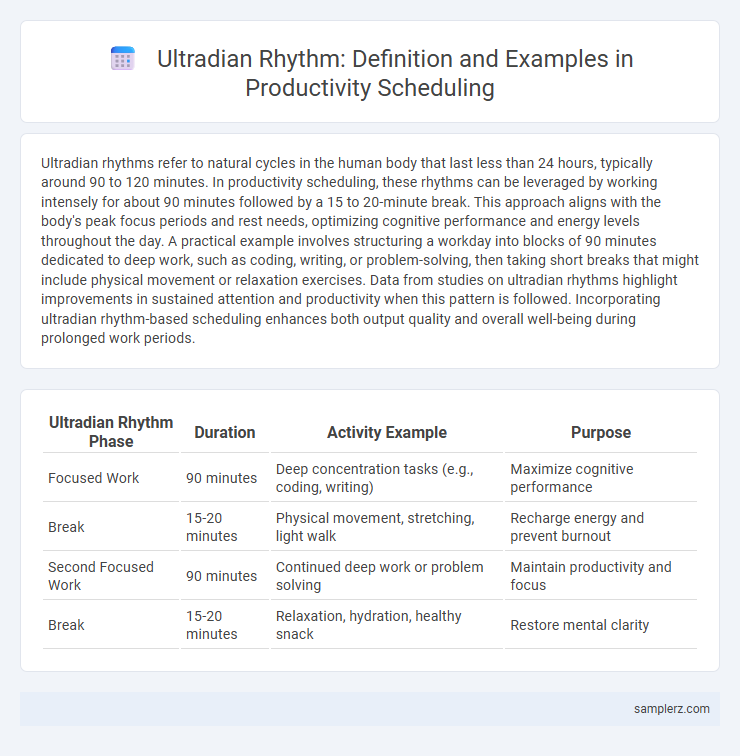Ultradian rhythms refer to natural cycles in the human body that last less than 24 hours, typically around 90 to 120 minutes. In productivity scheduling, these rhythms can be leveraged by working intensely for about 90 minutes followed by a 15 to 20-minute break. This approach aligns with the body's peak focus periods and rest needs, optimizing cognitive performance and energy levels throughout the day. A practical example involves structuring a workday into blocks of 90 minutes dedicated to deep work, such as coding, writing, or problem-solving, then taking short breaks that might include physical movement or relaxation exercises. Data from studies on ultradian rhythms highlight improvements in sustained attention and productivity when this pattern is followed. Incorporating ultradian rhythm-based scheduling enhances both output quality and overall well-being during prolonged work periods.
Table of Comparison
| Ultradian Rhythm Phase | Duration | Activity Example | Purpose |
|---|---|---|---|
| Focused Work | 90 minutes | Deep concentration tasks (e.g., coding, writing) | Maximize cognitive performance |
| Break | 15-20 minutes | Physical movement, stretching, light walk | Recharge energy and prevent burnout |
| Second Focused Work | 90 minutes | Continued deep work or problem solving | Maintain productivity and focus |
| Break | 15-20 minutes | Relaxation, hydration, healthy snack | Restore mental clarity |
Understanding Ultradian Rhythms: The Science Behind Productivity
Ultradian rhythms refer to natural biological cycles lasting about 90-120 minutes, during which energy and focus fluctuate. Incorporating ultradian rhythm scheduling into productivity practices means working in focused intervals aligned with these cycles, followed by short breaks to optimize mental performance and prevent burnout. Research shows that respecting these innate patterns enhances concentration, creativity, and overall efficiency throughout the workday.
How Ultradian Rhythms Enhance Focus in Work Schedules
Ultradian rhythms, which cycle approximately every 90 to 120 minutes, enhance focus by aligning work schedules with natural energy fluctuations. Incorporating these rhythms into daily planning allows for periods of intense concentration followed by short breaks, optimizing cognitive performance. Research shows that adhering to ultradian cycles reduces fatigue and sustains productivity throughout the workday.
Optimal Work-Break Cycles: Applying the 90-Minute Ultradian Principle
The 90-minute ultradian rhythm suggests scheduling work sessions in cycles of approximately 90 minutes followed by a 20-minute break to maximize productivity and maintain high focus levels. Research shows that during these cycles, cognitive performance peaks and then dips, making timely breaks essential for mental recovery and sustained efficiency. Implementing work-break cycles aligned with ultradian rhythms enhances concentration, reduces fatigue, and supports long-term productivity in professional and creative tasks.
Real-Life Examples of Ultradian Rhythm Scheduling at Work
Implementing ultradian rhythm scheduling by working in 90-minute intervals followed by 20-minute breaks aligns with natural energy cycles, enhancing sustained focus and productivity. For example, software developers at Google follow this pattern to maximize coding efficiency and reduce burnout. Research at the University of Rochester demonstrates that employees adhering to ultradian breaks maintain higher concentration and exhibit improved task performance throughout the workday.
Crafting a Daily Workflow Based on Ultradian Productivity Blocks
Ultradian rhythms, typically lasting 90 to 120 minutes, can enhance productivity by structuring work into focused intervals followed by short breaks. Scheduling high-concentration tasks within these natural energy cycles aligns cognitive performance with biological patterns, reducing burnout and sustaining mental clarity. Integrating ultradian productivity blocks into daily workflows boosts efficiency by leveraging inherent fluctuations in attention and energy levels.
Benefits of Ultradian Rhythm Scheduling for Remote Teams
Ultradian rhythm scheduling enhances remote team productivity by aligning work intervals with natural 90- to 120-minute energy cycles, promoting sustained focus and reducing mental fatigue. Incorporating regular breaks following each ultradian cycle supports cognitive recovery and improves overall task performance. This approach fosters better time management, increases motivation, and enhances collaboration among distributed team members.
Case Study: Productivity Gains with Ultradian Rhythm Schedules
The Case Study on Productivity Gains with Ultradian Rhythm Schedules highlights significant improvements in focus and output by aligning work intervals with 90- to 120-minute natural energy cycles. Participants reported sustained concentration and reduced burnout when tasks were segmented according to ultradian rhythms, optimizing cognitive performance. Data reveals a 25% increase in task completion rates and enhanced mental clarity during peak phases of these biological cycles.
Designing Meetings Around Ultradian Performance Peaks
Designing meetings around ultradian rhythm peaks enhances productivity by aligning sessions with natural 90- to 120-minute cycles of heightened focus and energy. Scheduling intense or collaborative meetings during these ultradian performance peaks maximizes cognitive function and engagement. Incorporating breaks after each cycle prevents fatigue, ensuring sustained attention and creativity throughout the workday.
Tools and Apps for Implementing Ultradian Rhythm Schedules
Tools like Timeular and Focusmate optimize productivity by aligning work sessions with ultradian rhythms, typically scheduling 90-120 minute focused intervals followed by 20-minute breaks. Apps such as Flow and Tide integrate ultradian cycle timers, promoting sustained concentration and natural energy fluctuations through customizable alerts. Utilizing these tools enhances cognitive performance and reduces burnout by syncing task management with the brain's biological cycles.
Overcoming Challenges When Using Ultradian Rhythms in Daily Planning
Ultradian rhythms, characterized by 90- to 120-minute energy cycles, can enhance productivity by structuring work sessions and breaks according to natural focus fluctuations. Overcoming challenges like inconsistent adherence requires implementing timed reminders and flexible scheduling tools to adapt rhythms to varying task demands. Integrating techniques such as the Pomodoro method or biofeedback apps helps align ultradian cycles with daily workflows, improving concentration and reducing burnout.

example of ultradian-rhythm in scheduling Infographic
 samplerz.com
samplerz.com